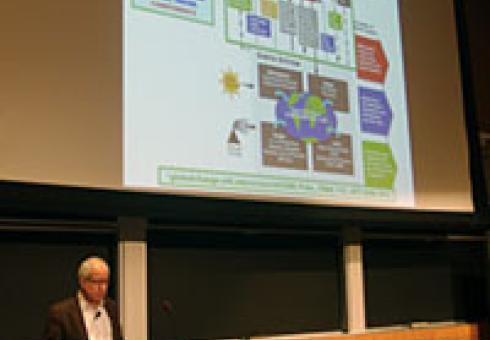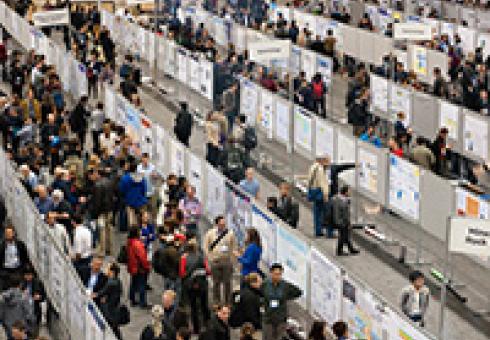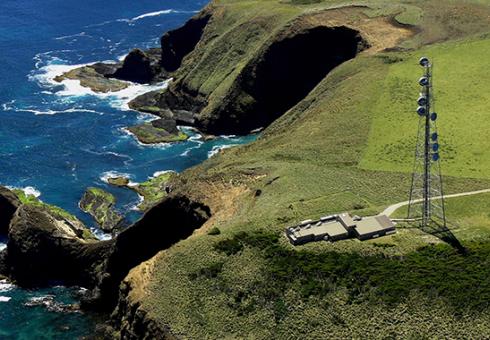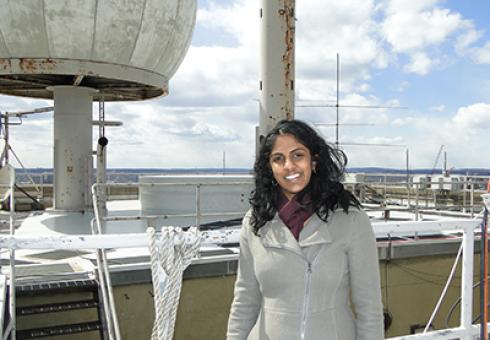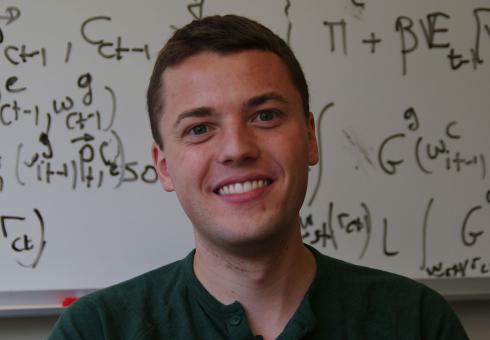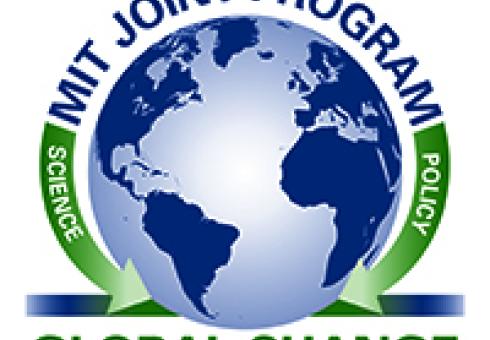Experts examine how MIT can be most effective in addressing climate-change issues
News and Outreach: Ronald Prinn
MIT will host a daylong symposium to address the nexus of science and action on climate change.
Helen Hill | EAPS
The MIT Department of Earth, Atmospheric and Planetary Sciences (EAPS), together with the Lorenz Center and the MIT Alumni Association, are hosting a climate symposium on Jan. 27 in the Kirsch Auditorium of the Stata Center (Room 32-123).
While this event is now fully subscribed, the day's proceedings will be available via a live webcast. (Register to watch.)
Taking action on climate change has become a dominating issue — globally, nationally, locally, and even here at MIT. Yet so many questions remain. How much and how quickly will climate change? How will these changes manifest, and where? What are the greatest risks posed by a changing climate and how likely are these worst-case outcomes? What is the science behind climate change, and how can basic research inform our efforts to avert, mitigate and adapt to its impacts?
Essential knowledge built through basic climate research lies at the core of all these questions. We would not even recognize that Earth’s climate is changing were it not for the cumulative efforts of climate scientists over the past five decades, many of them here at MIT. And we cannot hope to improve the climate outcome for ourselves and future generations without the vital, ongoing contributions of fundamental climate science research.
Touching on everything from the essentials of planetary climate through the complexities of Earth’s climate system to the challenges of finding the will to act on our knowledge to address current climate change, the symposium features talks and discussion by faculty experts from across the spectrum of climate research at MIT, plus keynote speakers Marcia McNutt (editor-in-chief of Science) and Justin Gillis (environmental science writer for The New York Times).
Speakers include:
Daniel Cziczo, MIT Department of Earth, Atmospheric and Planetary Sciences
Elfatih A. B. Eltahir, MIT Department of Civil and Environmental Engineering
Lindy Elkins-Tanton, Arizona State University
Kerry Emanuel, MIT Earth, Atmospheric and Planetary Sciences
John Fernandez, MIT Environmental Solutions Initiative
W. Eric L. Grimson, MIT Chancellor for Academic Advancement
Valerie Karplus, MIT Sloan School of Management
Thomas Malone, MIT Sloan School of Management
John Marshall, MIT Department of Earth, Atmospheric and Planetary Sciences
David McGee, MIT Department of Earth, Atmospheric and Planetary Sciences
Ronald Prinn, MIT Department of Earth, Atmospheric and Planetary Sciences
Sara Seager, MIT Department of Earth, Atmospheric and Planetary Sciences
Noelle Selin, MIT Institute for Data, Systems and Society and Department of Earth, Atmospheric and Planetary Sciences
Lawrence Susskind, MIT Department of Urban Studies and Planning
Dennis Whyte, MIT Department of Nuclear Science and Engineering
Maria Zuber, MIT vice president for research
For more information and a detailed agenda, visit the EAPS symposium website.
Image: Jennifer Fentress/EAPS
Former executive director of MIT Energy Initiative describes roadmap for averting devastating climate change.
David L. Chandler | MIT News Office
Melanie Kenderdine, as the first executive director of the MIT Energy Initiative (MITEI), helped to launch an international program to increase women’s participation and leadership in the energy field called Clean Energy Education and Empowerment, or C3E, in 2012.
Last Thursday, Kenderdine, now the director of the Office of Energy Policy and Systems Analysis at the U.S. Department of Energy, returned to MIT to give the keynote address at the fourth annual U.S. C3E Women in Clean Energy symposium and awards program. Creating this event to recognize women in a variety of energy disciplines at all stages of their careers, she said, “was one of the most rewarding experiences I’ve ever had.”
In her talk at the two-day MITEI event, Kenderdine focused on the DOE’s recently released Quadrennial Energy Review, a project initiated by Secretary of Energy Ernest Moniz, MITEI’s former director, to outline priorities for the nation’s energy research and policies over the coming years. The report, she said, gives a sense of the “key drivers and challenges” in the field of energy.
Kenderdine began by recapping the scientific understanding of the threat of climate change, using a depiction of the probabilities of various outcomes developed by Ronald Prinn, co-director of MIT’s Joint Program on the Science and Policy of Global Change.
Prinn used a pair of roulette wheels to starkly communicate the dangers of inaction: The wheel reflecting the probabilities under a “business as usual” scenario shows a significant probability of an average temperature increase of 7 degrees Celsius by the century’s end — an outcome that Kenderdine deadpanned would be “shall we say, transformational for the planet.” (Most scientists agree that any increase of more than 2 C could produce catastrophic results.)
But that outcome is far from predetermined, she emphasized. In the corresponding roulette wheel, assuming that the world’s nations agree to substantial curbs in greenhouse gas emissions, the probability of exceeding that limit drops substantially. And there are indeed many options available to make such reductions practical, Kenderdine said.
Showing a chart of the sources and uses of the world’s various kinds of energy, Kenderdine pointed out that almost half of the world’s energy is wasted. Curbing even a fraction of that waste could make substantial dents in emissions.
That’s only one piece of the puzzle, since with growing population and rising standards of living, the world will consume a projected four times as much energy by 2100 as is used today, Kenderdine said. But there are some encouraging signs already.
Greenhouse gas emissions have actually been declining slightly, for example, even as world GDP has increased — providing a stark refutation of claims that the two measures change in lockstep. This is partly due to a dramatic shift from coal to natural gas, she said — a change largely enabled by DOE-funded innovations: “The DOE invested heavily in shale gas technology,” Kenderdine said.
But because energy industries are capital-intensive, with expensive plants built to operate for many decades, it is essential to have clear priorities for future development, so as to avoid huge investments in plants whose energy may grow incompatible with future economic and regulatory conditions.
One key need, Kenderdine said, to enable the new energy developments that are most needed, is a drastic modernization of the electric grid, which has grown up piecemeal over the last century. Another priority is to enhance the resiliency and reliability of the nation’s existing energy systems, she said.
For example, Kenderdine pointed out, 10 percent of the nation’s oil supply — the Strategic Petroleum Reserve — is held in tanks at a single location in Cushing, Oklahoma — right in the middle of “Tornado Alley.” And over 50 percent of the nation’s refining capacity is along the Gulf Coast, an area susceptible to intense hurricanes.
Some needed changes are in the regulatory domain, Kenderdine said. For example, current federal laws on replacing energy infrastructure after a natural disaster require replacing a facility as it was before the disaster, rather than allowing for modernization or improvement.
Another area where modernization is desperately needed, she said, is in natural gas delivery: Many gas lines in cities are decades old. Recent explosions in major cities have shown the dangers of leaking gas pipes, and the need for replacing those old pipes: An explosion that leveled an apartment complex in New York last year, for example, involved a pipe system that was 104 years old. Boston, Kenderdine pointed out, has had thousands of gas leaks reported in the last few years, compared with just a handful in similarly sized Indianapolis, which modernized its pipes a few years ago.
The DOE’s Quadrennial Energy Review, Kenderdine said, includes 63 specific recommendations, which would likely have a total cost of $10 billion to $12 billion over the next decade. But there are great opportunities for improvements, particularly in the developing world, she said, where in many cases it may be possible to move directly into more efficient, modern generating and distribution systems.
Such developments, Kenderdine said, can “make a huge difference in people’s lives.”
The C3E symposium and awards program is a partnership of DOE and MITEI, under the auspices of the multi-governmental Clean Energy Ministerial.
Photo: Melanie Kenderdine (Photo by Justin Knight)
In an interview with The New Times, MIT Professor Ron Prinn says the new AGAGE climate observatory in Rwanda will help educate Rwandans interested in atmospheric science.
Solomon Asaba | The New Times
Researchers at Massachusetts Institute of Technology’s Centre for Global Change Science are in advanced stages to start a climate observatory centre in Rwanda, next year, with an aim of collecting atmospheric observations from the slopes of Mt. Karisimbi, a volcano located in the northwest of Rwanda. The project is spearheaded by Prof. Ron Prinn, a professor of atmospheric science, department of Earth, Atmospheric and Planetary Sciences at the university. The New Times Solomon Asaba had an interview with him.
Excerpts.
Whom are you collaborating with to start this observatory and how much has been achieved so far?
The observatory is a partnership between the Government of Rwanda and the MIT Centre for Global Change Science. We already have in place an interim observatory that has been placed on Mt. Mugogo and is operated mainly by Rwandans.
What kind of information will be obtained at the observatory and who will have access to its final site?
The observatory will measure the composition of air coming from East and South Africa as well as the Middle East and India.
The final site for the observatory is the summit of Mt. Karisimbi. When the Cable Car for ecotourism is complete, all scientists will be in position to access this summit.
How will Rwandans benefit from this kind of modern facility?
If the observatory is successful, it will help educate Rwandans interested in atmospheric science. It will join the Advanced Global Atmospheric Gases Experiment (AGAGE), a global network measuring greenhouse gases and other climate driving agents. Rwandans are already on their way to running the observatory.
Read the full article at the New Times.
The Advanced Global Atmospheric Gases Experiment tracks global emissions and atmospheric data, but lacks data on Africa. Jimmy Gasore, 4th-year MIT graduate student, is trying to change that.
by Zach Wener-Fligner, MIT News correspondent
All around the planet, high-frequency climate observatories are collecting atmospheric data around the clock as part of the Advanced Global Atmospheric Gases Experiment (AGAGE), a 35-year-old project to study emissions and climate change.
But there’s one problem: Despite a network of observatories that covers much of the globe, AGAGE lacks data on Africa — the world’s second-largest continent.
That’s something that Jimmy Gasore, along with other scientists, is trying to change. Gasore, a fourth-year graduate student in MIT’s Department of Earth, Atmospheric and Planetary Sciences under Ronald G. Prinn, the TEPCO Professor of Atmospheric Science, is working with research scientist Katherine Potter to build the first high-frequency climate observatory in all of Africa.
Once finished, the observatory will sit atop Mount Karisimbi, on the border between Rwanda and the Democratic Republic of Congo, at an elevation of nearly 15,000 feet. (Climate observatories are often built at high elevations so that researchers can cast a wider net, collecting data from a much larger surrounding region.) For now, it’s located at about half that elevation, on Mount Mugogo in Rwanda — making for more efficient work, since the hike up Karisimbi takes two days.
It’s a project that will fill a large hole in our current understanding of emissions of greenhouse gases — especially those coming from agricultural activities, wildfires, and deforestation. This will lead not only to better climate predictions, but also support regional and global climate-change mitigation strategies.
It’s also a highly personal project for Gasore, a citizen of Rwanda.
“We don’t know about African emissions, and we don’t have enough studies in Africa,” Gasore says. “It’s worth doing this study that has the potential to actually change people’s lives. It’s very gratifying to do research that actually affects people.”
Doing what felt right
Growing up in a village in southwestern Rwanda, Gasore used to watch the shadow cast by his house to predict when his mother would come home each day from her job as a schoolteacher — the first time he ever felt like he was really using science.
Gasore was also innately fascinated with how things worked: He was transfixed when he saw mechanics poking around car engines, and would stare as they struggled with the machinery.
“Even today I can watch road work, and tractors, for hours,” he says.
His father was trained as a nurse, but ran an electronics repair shop, fixing radios and televisions. Just from hanging around his father’s shop, a young Gasore learned about electronics by tinkering.
School wasn’t mandatory in Rwanda when Gasore was growing up, but his parents put a heavy emphasis on education for him and his five siblings. He learned to read French when he was 5, but didn’t attend school until he was 7. His father soon started to bring him books on computers and physics.
It just so happened that he had a knack for school — and for math, in particular. At the end of his primary schooling, Gasore was the best student in his district, and then placed third in a nationwide examination. He was awarded a scholarship to the National University of Rwanda, where he studied theoretical physics, graduating first in his class in 2007.
After finishing college, Gasore reached a crossroads. He stayed at the university and worked as a teaching assistant, but could feel himself growing disenchanted with the ethereal world of theoretical physics.
“When I finished I found that I wasn’t well connected with the real world,” he says. “I knew things, but couldn’t actually talk to people and tell them what I knew.”
Gasore was interested in climate science because it offered a mix of the theoretical and the practical. “I love using my theoretical knowledge on real-life problems,” he says.
Before long, an opportunity came knocking. Gasore was familiar with MIT, and the National University of Rwanda had partnerships with the Institute through OpenCourseWare and iLab. When Potter — now his colleague — came to visit Rwanda as part of her research, Gasore asked to meet her.
Potter was impressed with Gasore’s interests and intelligence, and advised him to apply to MIT. He did, and was accepted. The following fall, he moved to Boston.
Carving a path at MIT
Initially, Gasore was surprised by the freedom he found at MIT: “My previous school was sitting in a class and having someone teach you what to do. So I liked getting to choose what I got to study — to have 20 options for classes and to get to choose four.”
He quickly immersed himself in student opportunities surrounding his studies, joining the Weather Forecasting Team, the Joint Program on the Science and Policy of Global Change, and the Center for Global Change Science. Recently, he was also awarded a Martin Family Fellowship for Sustainability, which supports MIT graduate students in environmental studies.
Gasore realizes the importance of being able to talk to policymakers.
“Policy meetings are about climate-change mitigation and emissions abatement. So you have to talk in those terms,” he says. “I think the Center for Global Change Science is very strong in emphasizing strong mathematical skills, but also keeping in mind that we are doing this for policy.”
Above all, Gasore is passionate about his work: “I enjoy doing it. That’s the motivation. That’s why I can spend the night here in the lab troubleshooting,” he says. “There’s a reward when you spend five hours on something and then at the end you see it working and you say, ‘Wow.’ That’s what keeps me going.”
AP, Seth Borenstein
WASHINGTON (AP) — Heat-trapping greenhouse gases in the atmosphere are building up so high, so fast, that some scientists now think the world can no longer limit global warming to the level world leaders have agreed upon as safe.
New figures from the U.N. weather agency Monday showed that the three biggest greenhouse gases not only reached record levels last year but were increasing at an ever-faster rate, despite efforts by many countries to reduce emissions.
As world leaders meet next week in South Africa to tackle the issue of climate change, several scientists said their projections show it is unlikely the world can hold warming to the target set by leaders just two years ago in Copenhagen.
"The growth rate is increasing every decade," said Jim Butler, director of the U.S. National Oceanic and Atmospheric Administration's Global Monitoring Division. "That's kind of scary."
Scientists can't say exactly what levels of greenhouse gases are safe, but some fear a continued rise in global temperatures will lead to irreversible melting of some of the world's ice sheets and a several-foot rise in sea levels over the centuries — the so-called tipping point.
The findings from the U.N. World Meteorological Organization are consistent with other grim reports issued recently. Earlier this month, figures from the U.S. Department of Energy showed that global carbon dioxide emissions in 2010 jumped by the highest one-year amount ever.
he WMO found that total carbon dioxide levels in 2010 hit 389 parts per million, up from 280 parts per million in 1750, before the start of the Industrial Revolution. Levels increased 1.5 ppm per year in the 1990s and 2.0 per year in the first decade of this century, and are now rising at a rate of 2.3 per year. The top two other greenhouse gases — methane and nitrous oxide — are also soaring.
The U.N. agency cited fossil fuel-burning, loss of forests that absorb CO2 and use of fertilizer as the main culprits.
Since 1990 — a year that international climate negotiators have set as a benchmark for emissions — the total heat-trapping force from all the major greenhouse gases has increased by 29 percent, according to NOAA.
The accelerating rise is happening despite the 1997 Kyoto agreement to cut emissions. Europe, Russia and Japan have about reached their targets under the treaty. But China, the U.S. and India are all increasing emissions. The treaty didn't require emission cuts from China and India because they are developing nations. The U.S. pulled out of the treaty in 2001, the Senate having never ratified it.
While scientists can't agree on what level of warming of the climate is considered dangerous, environmental activists have seized upon 350 parts per million as a target for carbon dioxide levels. The world pushed past that mark more than 20 years ago.
Governments have focused more on projected temperature increases rather than carbon levels. Since the mid-1990s, European governments have set a goal of limiting warming to slightly more than 2 degrees Fahrenheit (1.2 degrees Celsius) above current levels by the end of this century. The goal was part of a nonbinding agreement reached in Copenhagen in 2009 that was signed by the U.S. and other countries.
Temperatures have already risen about 1.4 degrees Fahrenheit (0.8 degrees Celsius) since pre-industrial times.
Massachusetts Institute of Technology professors Ron Prinn, Henry Jacoby and John Sterman said MIT's calculations show the world is unlikely to meet that two-degree goal now.
"There's very, very little chance," Prinn said. "One has to be pessimistic about making that absolute threshold." He added: "Maybe we've waited too long to do anything serious if two degrees is the danger level."
Click here to read the rest of the AP story.

